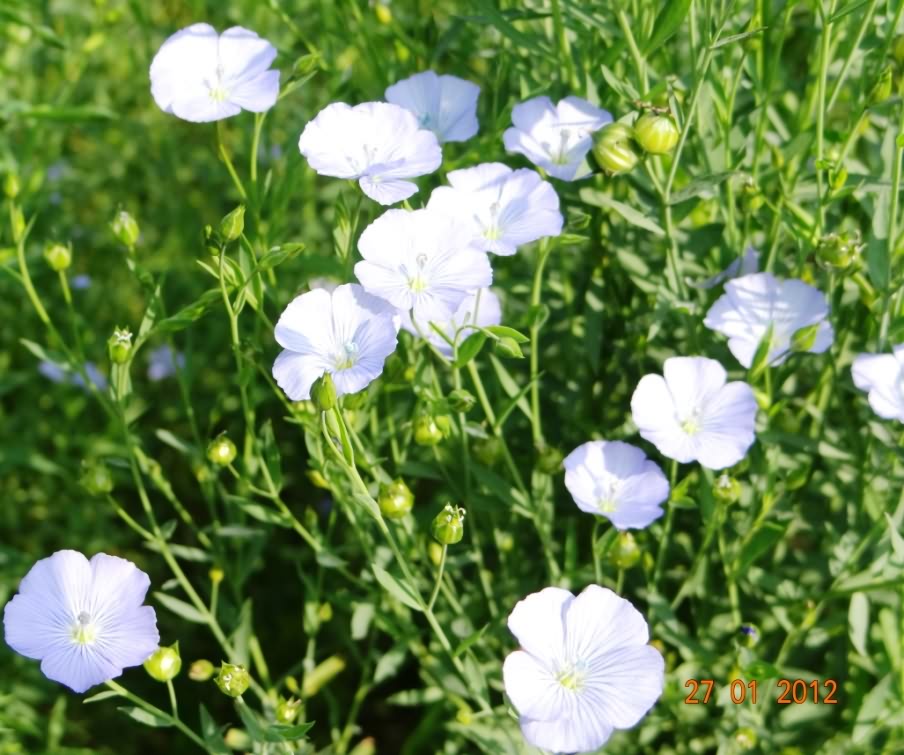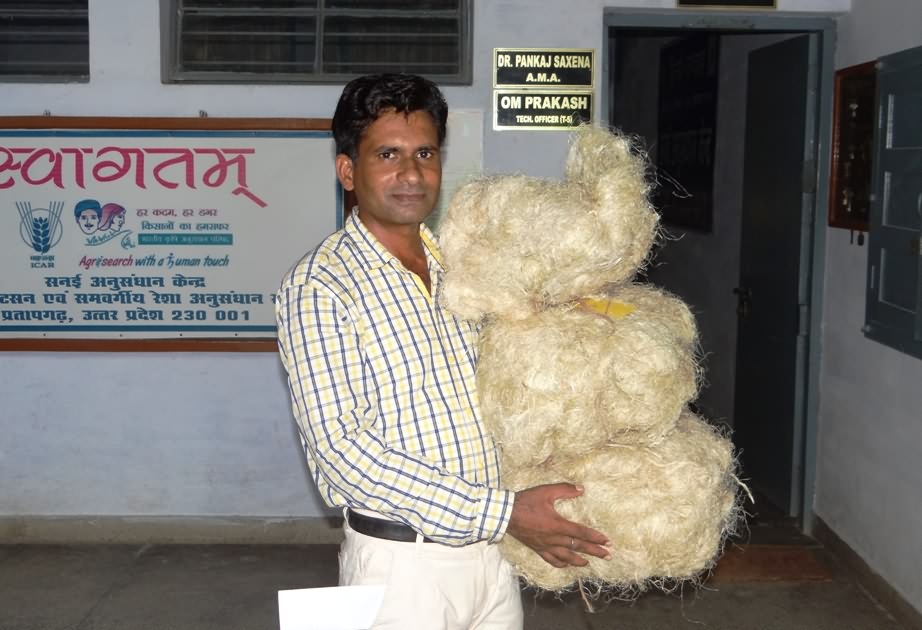अलसी (फ्लैक्स रेशा फसल) की खेती कैसे करें?
 Flax is a fibre crop, which is a member of the genus Linum and belongs to the family Linaceae. Botanically, flax and linseed are same but when it is cultivated for oil then it is known as Linseed and when it is cultivated for fibre it known as Flax.
Flax is a fibre crop, which is a member of the genus Linum and belongs to the family Linaceae. Botanically, flax and linseed are same but when it is cultivated for oil then it is known as Linseed and when it is cultivated for fibre it known as Flax.
Oilseed and fiber varieties are specialized development of this species. The flax cultivars grown primarily for seed/ oil purpose are relatively short in height and possess more secondary branches and seed capsule.
The flax cultivars grown for fiber purpose are tall growing with straight with 100-125 cm height and have fewer secondary branches. Flax or linseed is an annual herbaceous plant with shallow root.
Flax fibre is strong, non-lignified, soft, flexible, lustrous, shining, pale yellow colour and possesses high water absorbency quality.
Flax contain 80-90% cellulose. It is valued for strength and durability excelling cotton and stronger than cotton, rayon or wool.
The ‘Linen’ obtained from flax fibre is one of the best raw materials for textile.
In India, Flax is commonly known as Alsi, Tisi, Avise Jinjalu, Jawas, Ali Vidai, Agasi, Pesi and Cheruchana Vithu.
At present India imports large amount of flax fibre while flax can be grown successfully in Himanchal Pradesh, Jammu and Kashmir, Uttrakhand, Tarai region of Uttar Predesh, West Bengal, plateau in Maysore, Madhya predesh, Chattisgarh, Maharastra, Assam, Bihar and and North East region
Climate for flax cultivation
Flax is a crop of the temperate zone and long day plant. Flax requires a cool humid climate temperature ranging from 100C to 270C, rainfall ranging from 155-200 mm with high humidity (60-65%) during growing season.
Fibre type generally require cool, moist climate, somewhat cloudy weather during growing season. Drought and high temperature of about 32°C during flowering stage reduces the yield.
The lower temperature 10-19 °C along with relative humidity of about 76% promotes the stalk height which is the most desirable character in flax. Warm and dry season after crop harvest at 120-125 crop age is good for retting and drying.
Soil type and land prepration for Flax fibre
The crop requires well drained having a sandy loam or loamy texture soil for high grade fibre production. A fairly good soil fertility status with pH varying from 5.5 - 7.0 are suitable for flax fibre cultivation. Regular supply of moisture and good drainage are equally essential.
One ploughing followed by two or three harrowing is sufficient to obtained fine tilth. There should be proper moisture in the soil at the time of sowing for good germination of seeds.
Flax crop varieties
Selection of quality seed is very much essential for flax fibre cultivation. India’s first flax fibre variety namely Tiara (JRF-2) is released in 2015. The fibre yield was recorded for Tiara is 12.04 q/ha with high fibre strength (25.55 g/tex).
Flax’s high yielding strains and about 140 germplasm Indian and exotic are being maintained at Sunnhemp Research Station (CRIJAF), Pratapgarh, Uttar Predesh.
Important improved strains (tall type) of flax fibres are JRF-1, JRF-2 (Tiara), JRF-3, JRF-4, FT-895, FT-896 and FT-897.
 Flax Seed Treatment and Sowing
Flax Seed Treatment and Sowing
Protection from seed born and soil borne diseases, the seeds should be treated from fungicide Bavistin (1.5 g/kg) or Thirum (3 g/kg) before sowing.
Flax is primarily a rabi season crop. Ideal sowing time for flax in India is Last week of October to first week of November, before the ambient temperature becomes too low to affects the seed germination.
Delay in sowing reduces fibre yield and fibre quality. Seeds are sown in 30 cm row spacing apart and the seeds are sown to be 1 to 2 cm depth.
Seed Rate for Flax sowing
Flax requires high seed rate from 40kg/ha for line sown and 60kg/ha for broadcasting method.
Seeds are sown close together in line to maintain 2-3 lines in one row. The closeness leads to intra-row competition among the plants and as well as prevents damage due to wind as the plants are slender.
The number of plants per unit area affects the branching, stem thickness and plant height.
Weeding in Flax crop
Flax competes rather poorly with weeds. Common weed are associated with flax are hirankhuri (Convolvulous arvensis), Cornopus didymus, Avena fatua, Plantago lanceolata, Poa annua and Vicia febaand.
Crop should be free from weeds up to 35 days after sowing. First hand weeding at 21-25 days and second hand weeding at 40-45 days should be done after sowing. At this time seedlings are thinned out to maintain plant to plant distance of 1 to 2 cm. Isoproturon 75 WP@1.0 kg/ha as post emergence at 35 days after sowing can help in weed control.
Fertilizer application in Flax crop
Better crop can be raised from the land rich in organic matter, manured with farm yard manure or cakes @ of 5tonn/ha.
Application of phosphatic fertilizers is prevent the lodging tendency combination of 60 kg N, 40 kg P and 40 kg K per ha was found best from the point of plant height under agro-climatic condition.
Application of half dose of nitrogen, full dose of Phosphorous and Potash is applied as basal dose while the remaining dose of nitrogen is applied about 35 days after sowing with first irrigation resulted in the highest plant height and stalk yield.
Irrigation in Flax crop
Flax crop can be grown in rainfed and irrigated condition as well but in irrigated condition, production can be increased more than rainfed conditions. Two irrigations favour the production of good quality fibre.
So first irrigation is applied at 35 days after sowing and second irrigation can be applied at 65 days cropage. Promising results were obtained with the irrigation at the seedling stage and after flowering.
Flax crop protection
Insects-pest and diseases are not major constraint in the flax crop. Only fusarium wilt is little problem at the seedling stage but it can be controlled by the application of Bavistin @1.5 g/lit.
Quality seed should be use for sowing and need based plant protection measures should be recommended for high fibre yield.
The Flax fibre crop matures in around 120-125 days. It is harvested before capsules maturation.
The optimum stage for harvesting is the 2/3rd of the plants portion of the crop turn yellow colour and 2/3rd leaves of plants are fallen.
The fiber degrades once the plant get brown colour.
Harvesting is done by pulling out the plants from the ground. Plants are tied in small bundles of 15-20cm diameter for retting.
Early harvesting may result in tender and fine fibre with low yield, while late harvesting may result in more yield but poor quality of fibre.
Retting of Flax fibre
After harvesting retting is traditionally carried out by placing the bundles in pond and get dipped properly into the pond through heavy weight so that bundles can get absorb the moisture.
Bundles are kept side by side horizontally and immersed in water 20-25cm deep with bamboo or stoned or wooden logs.
The retting process is completed within three days (72 hours). Clostroridium bacteria are associated with the soil of stem and help in early retting of bundles.
After three days the bundles are washed thoroughly with fresh water. After washing, these bundles are stand on ground for sun drying.
Fibre extraction from flax plants
Flax fibre is extracted from the bast or skin of stem of the flax plant. The upper tender portions of retted plants are cut so those capsules are removed from plants. After that flax fibre is ready for scutching. Scutching is a process in which the fibres separates from stem. The scutching of fibre can be done following two procedures.
1. Mannual method
In this methods the small bundle of dried stalk are beaten by hand mallat (mungri). Owing to this wodden part of the stalk will split out and fibre can be separate easily. But this method is used at small scale at farmr’s house.
2. Mechanical method
In this method the flax stalks go through the machine process. The CRIJAF (ICAR), Barrackpore has developed a scotching machine for extraction of flax fibre. The machine is indigenously designed on the principle of passing a handful flax stalk through fluted rollers to break the woody core into straw and separate the fibre in a short time. The fibre is then worked through a comb for separating long fibres from short ones. The separated fibres strands are then rolled into bundles.
Diversified uses of Flax / Linseed
Flax fiber is extracted from the bast or skin of the stem of the flax plant. Flax fiber is soft, lustrous and flexible. It is stronger than cotton fiber but less elastic. The best grades are used for linen fabrics such as damasks, lace and sheeting.
Coarser grades are used for the manufacturing of twine and rope. Flax fiber is also a raw material for the high-quality paper industry for the use of printed banknotes and rolling paper for cigarettes and tea bags.
Flax is woven into fine such as lawns, cambrics and also drills, canvas and Buckrams. It is used in linen stiching, making twins and nets for fishing, ropes, carpets backing, sails, wrapping cloth and house furnishings.
It is a good row material for tissue papers, fire fighting hose pipes, knapsacks and waterbags. In ancient time it was used in wrapping to mummies. Owing to its good length, flax fibre is suitable for strong yarns such as used for sowing threads and cloth.
Flax fibre which is fairly strong is extremely porous and absorbs moisture rapidly such that it makes excellent towels, dry clothes and water holding articles.
The great strength, fineness, durability, better resistance to environmental fluctuations is some of the characteristics of flax fibre that make it indispensable during war period. It is also used for high quality paper used in currency notes and bond papers etc.
Flax seed contain high level of lignans and Omega-3 fatty acids. Lignans may benefit the heart, possess anti-cancer properties.
The flax seed taken in the diet may benefit individuals with certain types of breast and prostate cancers. It may also lessen the severity of diabetes by stabilizing blood-sugar levels.
Authors
1Babita Chaudhary , 2MK Tripathi and 3HR Bhandari
1 Senior Scientist, ICAR- Central Potato Research Institute Campus, Meerut, UP
2 Principal Scientist, ICAR-Sunnhemp Research Station (CRIJAF), Pratapgarh, UP
3 Scientist, ICAR-Central Seeed Research Station for Jute and Allied fibres (CRIJAF), Budbud, Burdwan, West Bengal
1Email:



